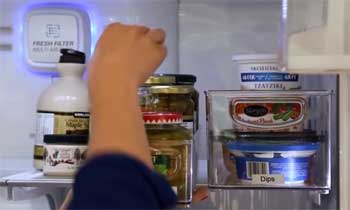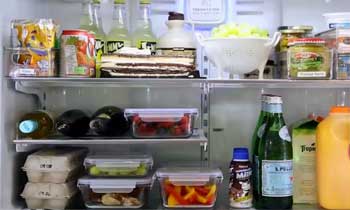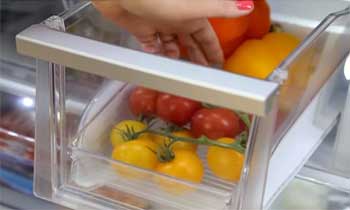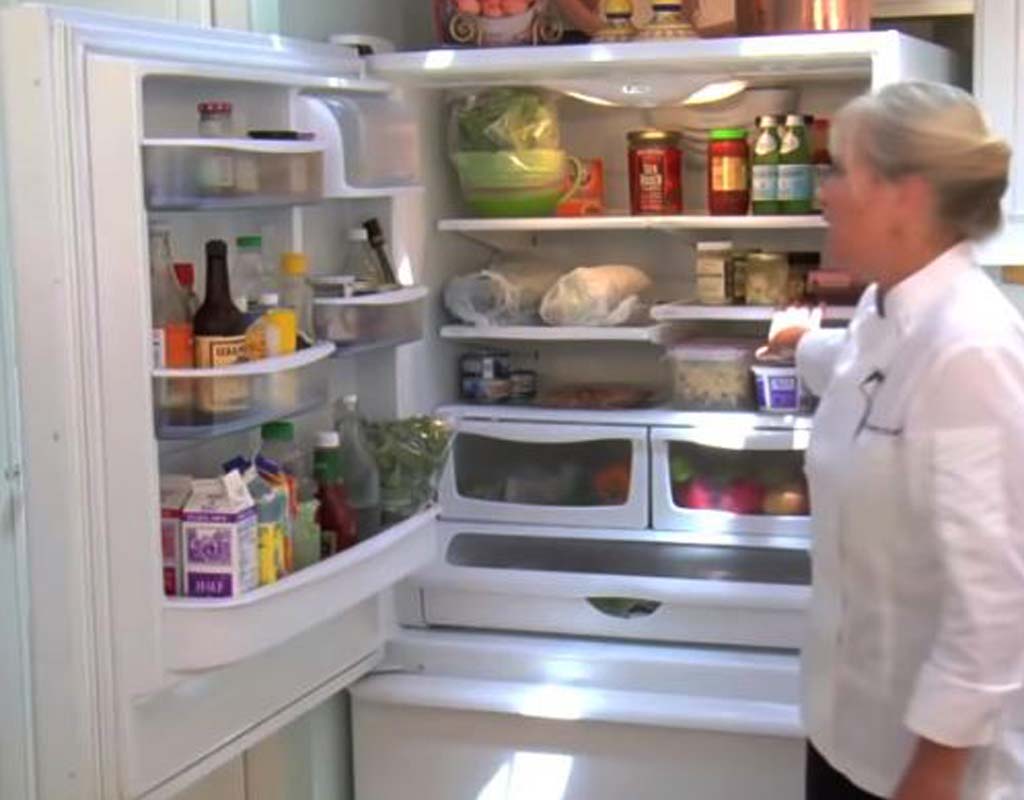'How to organize your refrigerator properly for food safety' is one of the simple tasks that many people find difficult. It is important for one to know what to put on the different compartments of the refrigerator. You should be careful not to mix foods that cannot stay together in one compartment and accelerate the rate of foods going bad. It is also good to learn how to organize the refrigerator and keep it clean at all times. An organized kitchen should have minimum food wastage. It is therefore very vital for the fridge to be used to store foods and keep them fresh for longer periods as compared to open shelves.
Things to avoid

Before we talk about How to organize Your Refrigerator Properly for Food Safety , there are things you should know and avoid them totally while keeping items in the refrigerator. The following are some of them .
Do not overfill your fridge
An empty fridge may be bad for you but stacking things in the refrigerator to its brim is a bad practice. An overfilled refrigerator will block air flow among the foods and make them go bad at a faster rate. Overfilling the refrigerator to every inch can also make you forget foods in the fridge for a long time only to discover them after they have gone bad an emitting a bad smell in the device.
Another issue with overfilling will be blocked air vents. Air circulation will be impeded and moisture exchange will be ineffective. You will be damaging foods in the fridge rather than preserving them when air vents are blocked. Keeping too many items will also reduce the energy efficiency of your refrigerator and too much energy will be used with less effect on cooling the foods.
Milk and eggs should not be stored in the door
Milk is one of the few foodstuffs that go bad at a very fast rate. The door and top shelf is significantly warmer than the middle and lower compartments. You should avoid keeping perishables on the warmer sections and use the middle compartment to store your milk. The middle compartment has cooler and regulated temperatures. The eggs are also perishable and they also need to be in the middle compartment and not in the door.
Store fruits as whole and not while sliced
Slicing fruits before storing them is a bad practice. This will increase the surface area exposed to the atmosphere and hasten the deteriorating process. To ensure that your fruits stay longer, keep them whole in the refrigerator and totally avoid cutting them. It will limit the access of food damaging agents unlike when cut open to expose the inner parts.
Do not keep fruits and vegetables in the same drawer
Fruits require different conditions for a lengthened lifespan from those conditions needed by vegetables. Vegetables will need high humidity so that they are kept freshy and to avoid drying. Fruits on the hand will need low humidity to keep longer without rotting since moisture increases the turgidity of their outer layers. Another issue is the ethylene gas emitted by ripened fruits. This chemical is harmful to vegetables and will make them rot faster.
Never keep meat on the upper shelves
Meat is another highly perishable food that needs care when storing in a refrigerator. Consider keeping it in the lower and bottom most compartments for the following reasons. In the lower compartments, meat can not drip onto any foods and this will reduce its contamination on other foods. When meat is kept with other foods it spread its smell to the foods. It is a disgusting feeling to take a fruit smelling like meat. You should place a tray under the meat to make cleaning easy in case of spillage.
Leftovers are always kept on the upper shelf
Food leftovers do not need storage for many days since they should be the ‘eat me first’ items when you open the fridge. The upper shelf is warm and will keep the food in good condition for a day before they are eaten. You do not need to keep leftovers too cold for easy warming once you resume eating.
Do not keep strawberries as fruits
Strawberries are a type of fruits that need high humidity to keep in good condition. You should therefore avoid keeping them with other fruits on a compartment with low humidity. Keep them together with vegetables in the veggies creeper where they will enjoy high humidity. Strawberries do not produce ethylene and will not make the vegetables go bad quickly.
Maintenance Ideas

With the following precautions in mind, you can now think of how to arrange foods in the refrigerator to create a good visual impression and for easy maintenance. Before storing items in the device, do the following things to help you clean and maintain the refrigerator easily.
Put kitchen linen or paper towels first
Having a removable cover below foods in the refrigerator will make it extremely easy for you to clean in case of spillage. With paper towels, all you will need is to wipe rather than deep cleaning your fridge very often. This will save you time and energy.
Normalize using bins, baskets and tray
On the normal kitchen pantry shelves, bins and trays are used and this can be copied into the fridge. You can use a bin to hold foods that do not fit in the door and keep them together on the upper shelve.
Use a colander to hold citrus fruits such as lemons and keep them separate from other fruits that produce ethylene such as bananas. This will help you avoid quick rotting of any of them.
A tray will then be ideal for holding meat in the bottom shelves where it will be easy to manage its dripping. Using a tray will help you clean off the meat drip and ensure it does not spoil other foods.
Use glass food containers for left overs
Using glass food containers will make it easy to spot foods in the fridge immediately you open it. It will be a lot of wastage going to buy some new rice in the market while you have left some in the fridge.
Simple Steps to Arrange your Refrigerator
To be able to arrange your items perfectly in the fridge without complicating issues, follow the simple steps below that will help you have an easy time with handling your refrigerator. With this strategy you will be able to avoid molding vegetables and rotting condiments in your fridge.
Step 1: Fully empty the fridge

This will require you to remove everything from the refrigerator and ensure it is entirely empty. This will allow you to see every form of dirt from stains to spills that have hardened. The perishables that you are fearing they may go bad when out of the fridge can be kept in a cooler with ice.
Step 2: Cleaning all the surfaces
Use a paper towel or some disinfecting wipe. You then take some disinfecting spray and spray all the fridge surfaces to sanitize them. Do this to all the shelf levels and the inside compartments of the door. Soak all the drawers in some hot and soapy water, wipe them and you can then put them back in the refrigerator.
Step 3: Reassembling and deodorizing
A deodorizer for refrigerator will be essential in your fridge as it prevents fouls smell from circulating around your fridge. Sodium carbonate is a cheap and good deodorizer. You can keep the deodorant in form of special fridge packets that stick onto the walls. The other way is using an open container directed towards the back of the refrigerator.
Step 3: Making an ‘eat me first box’

This will be designed for highly perishable items. You can also place the foods that are just about to expire in the box to be consumed first before the rest of the foods. Dispose the items that you are unsure whether they have gone bad or not. Leftovers should be labelled with the day they were made and a chart from foodsafety.gov should be used to determine how long they will last.
Step 4: Using a lazy Susan
It is very easy for foods to get forgotten and expire at the back of the fridge where they cannot be easily identified. This is where a lazy Susan becomes of importance. The device spins allowing you to access every item on it from the front side of the refrigerator.
Step 5: Utilizing space with baskets
Tiny and small things can easily get lost inside the fridge. All you need to fight this is by having baskets that will stick to the sides of your refrigerator using suction cups. This will help you keep and easily retrieve items like cheese rollups, premade lunch meat, string cheese and small hummus cups in the baskets stuck on the wall inside your fridge.
The lower shelf is more ideal for raw ingredients that are intended to stay longer in the fridge. The subsequent steps will help you organize the lower shelves.
Step 6: Grouping like items
To make accessibility easier and retrieval of food items, keeping like items in the same baskets is a brilliant idea. Smoothie ingredients will be kept together in the same basket while leftovers will be together but in another different basket.
Step 7: Storing snacks with file organizers
They are boxes with shapes that accommodate all types of snacks perfectly. They reduce paperwork as they can simply be labelled with a pen. They are good for the fridge though everything has been digitalized. You will be able to keep containers with chopped veggies, applesauce pouches, yoghurt and pouch drinks.
Step 8: Putting curtain ring clips
At the edges of shelves in most refrigerators are wire shelves or bars. Shredded cheese, lettuce or other bagged items can easily be hung from the shelve edges and allow the user to utilize the space below. Ringed curtain clips do this job wonderfully. All you will need is to clip the curtain ring clips and hang your rolled baggage from them as required.
Step 9: Using drawer dividers
These are needed in the crisper drawers of your fridge. The crisper drawers are often temperature and humidity controlled to allow storage of certain types of fresh foods longer. Some foods such as veggies and strawberries will need more humidity while others such as fruits will need less. You need to know what is kept where among fruits and vegetables under the humidity controls present.
The dividers that are normally used for cloth drawers can be comfortably used in the crisper drawers of the fridge. Ensure that you purchase those that will perfectly fit inside your refrigerator and organize them in the fridge according to how you will like it. Greens like lettuce and spinach can be grouped together, onions, ginger and garlic grouped together in another section while other veggies like carrots and French peas will be kept together in another section.
Step 10: Learn the humidity controls
Knowledge on the humidity settings is important to enable your fruits and vegetables last for a longer time. There are high and low options. You can set one drawer for vegetables to high humidity while the other one for fruits, set it to low humidity.
Low humidity drawer is for the items that rot easily such as fruits and vegetables that emit ethylene gas. This gas causes ripening of fruits and a faster expiry. The high humidity drawer should be for leafy greens like spinach and herbs. Moisture keeps them crispy and fresh for long hours.
Step 11: Keep condiments in door hacks
This is the warmest part of the fridge. You need to avoid keeping milk or eggs here. Sauces, condiments and sandwich dressings should go here since they are less perishable and can keep long at warm temperatures.
Step 12: Label the door compartments
All like items should be put together in each door divider and the dividers labelled well with a magnet or sticker. You should keep the door dividers organized too.
You will also need to use egg cartons for condiments storage. The bottles should be kept upside down and tightly closed.
Step 13: Have a lower shelf for kids
A low shelf that is accessible by kids should be used to store their drinks. This will ensure they do not tamper with other foods as they struggle to take something from the top shelf.
With these procedures, your refrigerator will forever be organized and amazing to look at when you open it. It will definitely reduce your food wastage to very low levels.
Discover more >>
Best Uses of Nonstick Cookware-Tips for Beginner in 2023
Safety and Maintenance Tips to Take Care of Nonstick Cookware Sets

